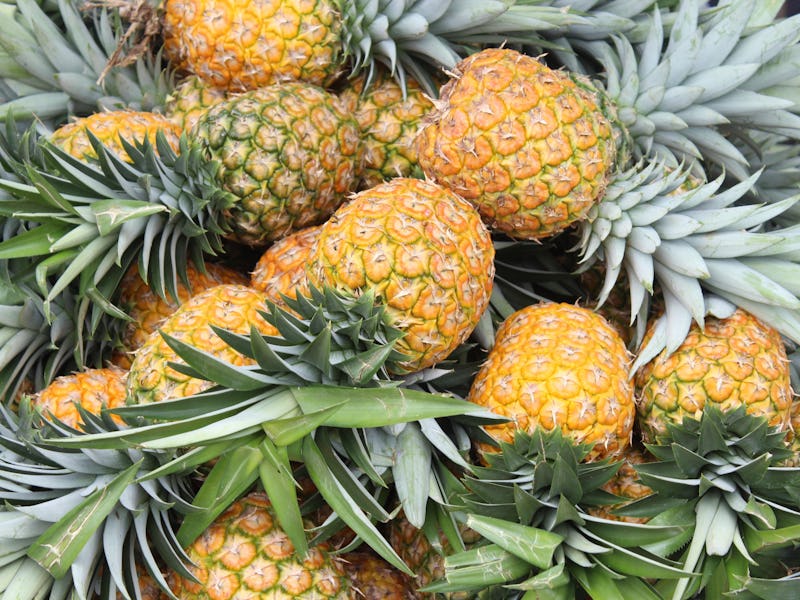Why does eating pineapple sting? A food scientist explains the chemistry
More like painapple, right?

If you’re still hung up on whether pineapple belongs on pizza (which it does, for the record), you’re asking the wrong questions. Everyone ought to be focusing on why sweet, refreshing pineapple, rich in vitamin C, manganese, vitamin B6, and other beneficial compounds, burns our mouths as we are trying to enjoy it.
Food scientist and professor at Rutgers University Karen Schaich explains the basic chemistry behind why pineapples cause our mouths so much burning pain.
Why does pineapple sting?
This fruit can taste the way it looks — prickly. The prickly sensation comes from a substance in fresh pineapple that erodes mucous membranes in your mouth. That substance is a protease called bromelain. Proteases are a particular type of enzyme, which facilitate chemical reactions in the body by breaking down specific proteins. Bromelain, which resides in pineapple, papaya, and figs, breaks down proteins called cysteine amino acids. It’s in every part of the pineapple — fruit, peel, leaves, stems. While it’s less concentrated in the fruit than in, say, the stem, it’s still potent enough to act on the amino acids in our mouths.
Bromelain “begins to break down the proteins that are in the mucous linings of your mouth, and on the surface of your tongue,” Schaich tells Inverse. This mucous lining, Schaich says, is made of proteins, which proteases act on. “When the proteases come in and break them down, those tissue layers are degraded,” she says.
On top of that, Schaich says, “pineapple is reasonably acidic.” Not only does bromelain break down the mucous linings — the underlying tissues are now exposed to the pineapple’s acid.
Bromelain has its advantages in food science, most prominently as a meat tenderizer. In fact, factories that can pineapple may use the leftover peels, stems, and leaves for meat tenderizers. The bromelain breaks down toughening cysteine proteins in meat. Marinating meat in fresh pineapple juice does the same.
Fresh-cut pineapple contains the protease bromelain, which eats away at the mucous lining of our mouths.
Is there a way to make it sting less?
Only fresh pineapple hurts us. Canned pineapple, however, doesn’t sting. Canned pineapple, like other canned foods, is thermally processed to prevent microorganisms from growing in storage.
Grilling and searing pineapple will also inactivate bromelain. Temperatures of about 160 to 175 degrees Fahrenheit (70 to 80 degrees Celsius) will tame pineapple.
Eating pineapple with other foods could ease the pain, too. This is where a Hawaiian pizza or tacos al pastor could save the day. “When you mix pineapple with foods, you’re diluting the effects,” Schaich says. Although, savory foods typically incorporate grilled pineapple, not fresh.
One popular weapon to defang bromelain in pineapple is saltwater. Some fruit aficionados recommend soaking cut pineapple in saltwater anywhere between 30 seconds and 30 minutes. Schaich is skeptical of this method but says some research does support it.
According to Schaich, there’s research that dunking pineapple in a saltwater solution with salt concentrations up to 1.5 percent (about a teaspoon of salt per cup of water) for 20 to 30 minutes reduced bromelain activity by 25 percent at most. She says any higher concentration may affect the fruit’s taste.
The salt may also cause bromelain’s structure to constrict. “This tightened structure changes the way the enzyme can interact with proteins so the protease activity is inhibited,” Schaich explains. If the salt warps the protease’s shape, then it can’t bind to and break down proteins like cysteine. However, this explanation doesn’t satisfy Schaich because these proteases are located within plant cells, protected by cell walls and membranes. Even 20 to 30 minutes of soaking likely isn’t enough time to penetrate at the cellular level, Schaich says. Still, that’s enough to inhibit enzymes near the surface, which could reduce the pain.
However, she has her own hypothesis. She notes that while pineapple isn’t a citrus, its acidity charts it between 3 and 4 on the pH scale (which measures a substance’s acidity or base on a scale of 0 to 14, where acid falls on the lower end). “Salt reduces the pH at which citric acid in pineapple dissociates,” she writes, meaning salt makes it so that citric acid more easily breaks down into simpler components.
One article suggests that salt triggers bromelain, so it’s inactive by the time it’s ready to eat. Schaich, however, says she could find no scientific literature confirming this hypothesis.
Fortunately, the pain of eating pineapple isn’t too strong, and its fresh sweetness outweighs the sting.
CHECK, PLEASE is an Inverse series that uses biology, chemistry, and physics to debunk the biggest food myths and assumptions.
Now read this: Can mad honey get you high? A bee expert reveals the answer
This article was originally published on